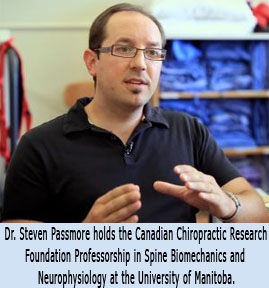Source The Vancouver Sun
by Dr Don Nixdorf
 Research is key to developing better treatments and care protocols to eliminate disease and stay healthy. The chiropractic profession is fortunate to have twelve Canadian Chiropractic Research Foundation (CCRF) research chairs in major universities across the country, each of which conducts and contributes to world class research. But the more significant benefits to weaving these research chairs into the fabric of academia are the interdisciplinary connections and collaborations that result. There is no other time in history where we have seen so many different health professions coming together with one common goal: improving healthcare.
Research is key to developing better treatments and care protocols to eliminate disease and stay healthy. The chiropractic profession is fortunate to have twelve Canadian Chiropractic Research Foundation (CCRF) research chairs in major universities across the country, each of which conducts and contributes to world class research. But the more significant benefits to weaving these research chairs into the fabric of academia are the interdisciplinary connections and collaborations that result. There is no other time in history where we have seen so many different health professions coming together with one common goal: improving healthcare.
When many different health professionals work together, patients routinely experience better care and are on average better prepared to care for themselves. There are several examples of this in practice already. St. Michael’s Hospital in Toronto uses a multi-disciplinary approach to treat and manage back pain. Community health clinics with nurse practitioners, dentists, nutritionists and several other health care providers are peppered throughout Canada and experience tremendous success in the amount of patients they can treat and the quality of the care that is delivered. Let’s also not forget our amazing Canadian athletes who benefit from a team healthcare approach. It makes perfect sense that patients benefit from having multiple perspectives of expertise that work together to treat the whole person, not just the corner of their body with a problem.
In an effort to gain further momentum to this type of approach and increase collaboration in the academic community, several chiropractic doctors out of McMaster University came together to form the McMaster Chiropractic Working Group in 2009. Dr. Steven Passmore DC, PhD, a researcher from the University of Manitoba is one of the founding members of this group that aims to raise the profile of chiropractic in the university setting through credible research and collaborative efforts. With the exception of the CCRF researchers in universities, chiropractic education and advancement is primarily through chiropractic schools and funded almost entirely by chiropractic doctors. Even after earning his PhD from McMaster in 2012, Dr. Passmore continues to be a part of this initiative that is setting an example for others across the country. BC is already investigating the potential of a local working group based on the McMaster model.
With his own research in Manitoba under his CCRF professorship, Dr. Passmore is applying science to support the awareness and understanding of spine and spine related problems for which patients seek care from their chiropractic doctor.; More specifically, what are the outcomes of care, who benefits and what are the referral patterns. There are thousands of patients on wait lists for surgeries and other procedures who may improve or at least sustain their existing quality of life with conservative care. The trick is to identify who these individuals are so they can receive this type of care leading up to their surgery or possibly avoiding it all together. Dr. Passmore is hoping to uncover some of these answers through his work.
This is where the interdisciplinary approach truly benefits the patient. Spine surgeons who work with chiropractic doctors can offer non-invasive therapy to patients to manage or improve their condition while on wait lists. Some patients may find a significant improvement while others may need to progress to a surgical intervention. The important part of the equation is that the patient is looked after every step of the way.
“Interdisciplinary” and “patient-centered care” are the buzz-words du jour but they really do speak to a better method of health delivery. With this practice becoming more and more common, hopefully we can expect an increase in the team care approach at our own local hospitals and clinics.


Leave A Comment